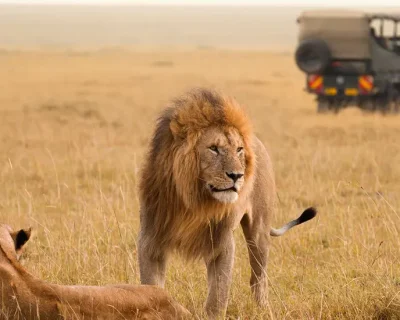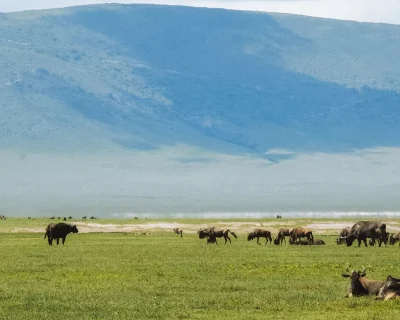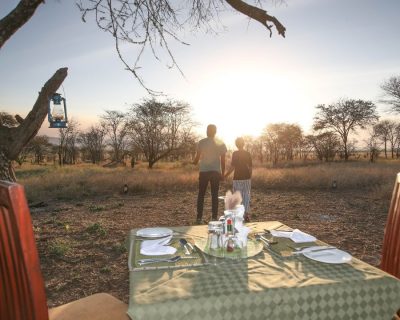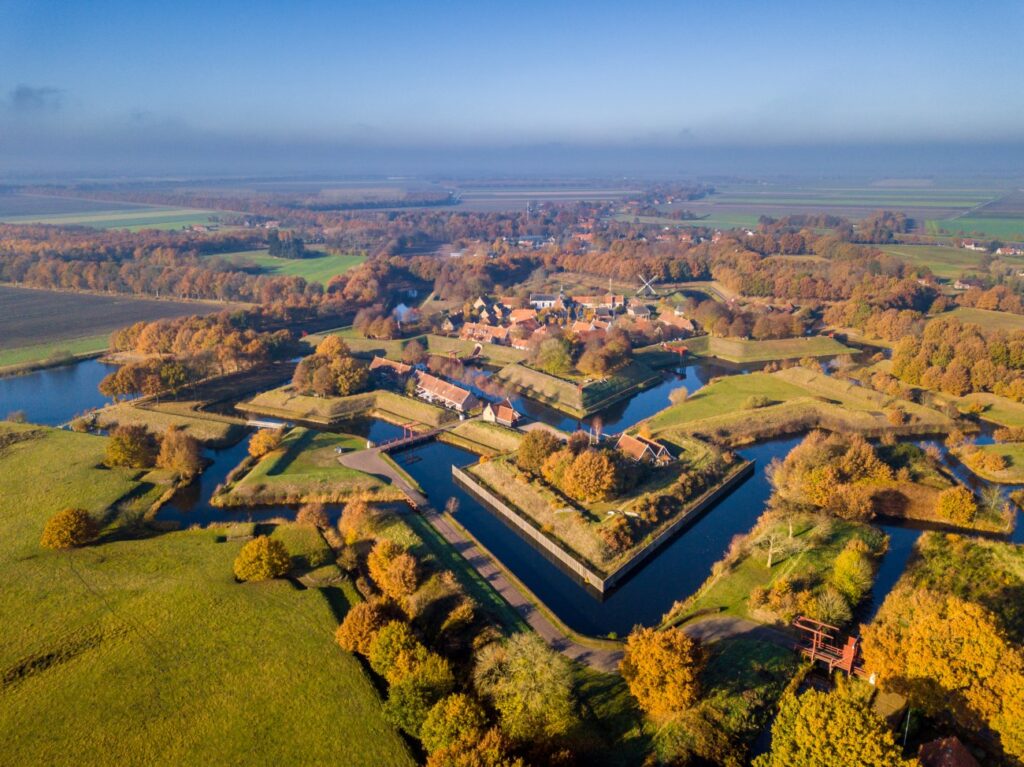Ngorongoro Crater is more than a destination—it’s a living theatre of nature. The volcanic caldera, encircled by towering walls, offers an intimate stage for some of Africa’s most dramatic wildlife interactions. But unlike other parks that shift slowly, Ngorongoro changes in subtle, soulful ways with every month. From misty mornings in the wet season to golden grass and roaring lions in the dry, every visit tells a different story.
Here’s your complete, expanded guide to when to go, what to expect, and who each season is best suited for.
🌿
January – Mist-Covered Mornings and New Beginnings
In January, Ngorongoro awakens in emerald tones. Rains from November and December have given life to the plains, cloaking the Crater floor in soft grasses, scattered wildflowers, and lingering mist. The mornings are hushed and cool, filled with the sound of birdcalls and the sight of newborn gazelles and wildebeest taking their first steps. The Crater is calm—but underneath that calm, the rhythms of life and survival are in full motion.
Wildlife:
This is calving season for many herbivores. Newborn wildebeests, zebras, and gazelles attract predators, creating fascinating encounters. Lions stalk the edges of open plains while hyenas trail behind, opportunistic and alert. Buffalo and elephants graze with ease, and the elusive black rhino often emerges in the soft light of morning. With food and water in abundance, animal movements are more dispersed, but the Crater’s enclosed nature still offers consistent game viewing.
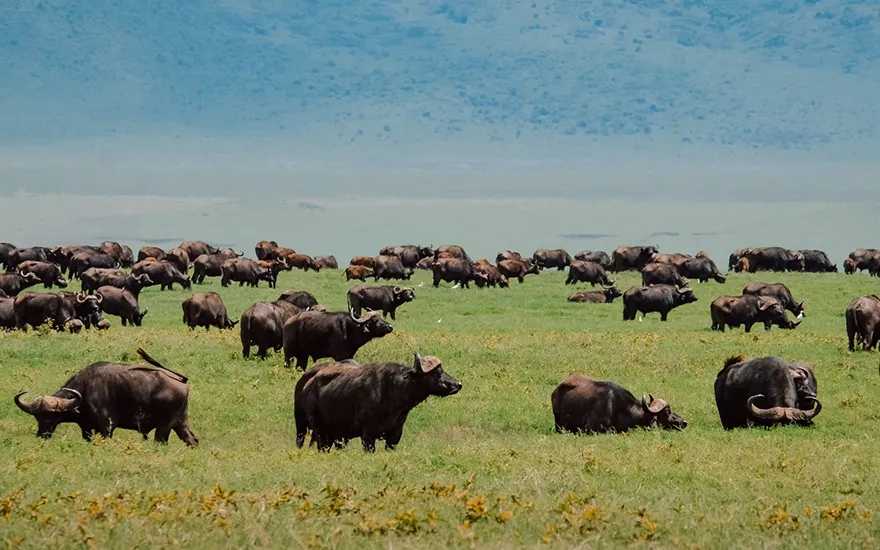
Birdwatching:
January marks the arrival of migratory birds from Europe and Asia. The crater lakes and Lerai Forest come alive with color and sound—flamingos wade through the alkaline waters of Lake Magadi, while bee-eaters, weavers, and raptors claim perches across the rim and acacia groves.
Weather:
Expect warm days, averaging 24–25°C (75–77°F), and refreshing afternoon showers. Mornings are cooler and misty, especially on the rim, which can dip below 10°C (50°F). The rains are typically brief and don’t interfere with game drives.
Photography:
The green season provides incredible contrast—bright grasses, dramatic skies, and moody fog. Early morning is prime time for both landscapes and wildlife, with diffused lighting that flatters every shot. Predator activity around young prey creates emotional, action-packed images.
Best For:
Couples seeking a peaceful, romantic experience; photographers chasing mood and color; and bird enthusiasts hoping to catch seasonal migrants.
🌿
February – Calving Season and Predator Patrols
February carries January’s energy forward, deepening the pulse of life across the Crater floor. Calves still totter beside their mothers, lions are alert and patient, and the landscape remains green and thick with promise. With fewer tourists than in peak months, February offers a quietly intense safari experience—one where life, death, and instinct play out in slow, watchful moments.
Wildlife:
Predator-prey interactions are at a high point, especially during the early mornings. Lion prides are often seen resting in the sun after a night of hunting. Hyenas laugh in the distance as jackals weave through the grasslands. Calving continues across the plains, especially for wildebeest, who rely on timing births to overwhelm predators. The Crater’s permanent water supply ensures that elephants, hippos, and buffalo stay close to the heart of the action.
Birdwatching:
This is still an excellent time for birders. The migratory influx continues, and many species—especially storks, rollers, and sunbirds—are now in breeding plumage, which makes them even more spectacular to observe and photograph. The lushness of the landscape provides ample feeding and nesting grounds.
Weather:
Temperatures hover around 25–26°C (77–79°F), with occasional light rains. Mornings are fresh and often foggy at the rim. Road conditions are good, as the long rains haven’t begun yet.
Photography:
Golden morning light breaking through cloud cover, predator shadows slinking through green grasses, and dramatic backdrops make February a favorite for serious photographers. The presence of young animals adds a tender dimension to storytelling through imagery.
Best For:
Photographers, couples, and solo travelers who want intimate encounters without the crowds. It’s also an ideal month for those focused on predator dynamics.

🌧️
March – Clouded Skies and Quiet Wonder
March signals the beginning of the long rains. The skies become more expressive, with heavy clouds rolling in over the Crater rim and lush vegetation swelling into every corner of the landscape. It’s a month of transformation and tranquility, where the pace slows down and the beauty deepens.
Wildlife:
Many animals begin to spread out as water becomes more abundant across the Crater floor. While the big cats may be slightly less active during daylight hours, elephants, hippos, and herbivores remain easy to find. Rhinos often retreat to more wooded areas, but early morning drives still yield strong chances.
Birdwatching:
March is arguably the best month for birding in Ngorongoro. Wetland birds thrive around the lakes and marshes, and migratory species are still present in large numbers. Breeding activity picks up, with nests spotted in forests and along escarpments.
Weather:
Rainfall increases, particularly in the afternoons and evenings. Expect daytime highs of 23–24°C (73–75°F) and regular cloud cover. Mornings can still be clear enough for good viewing and travel.
Photography:
Soft, filtered light through cloud cover, rain-slicked plains, and mist rising from crater walls create atmospheric photos. Photographers should come prepared with waterproof gear to protect cameras during surprise downpours.
Best For:
Budget-conscious travelers and birders who don’t mind a little rain in exchange for quiet drives and exclusive views. Also ideal for guests who want a peaceful safari away from peak-season pressure.
🌧️
April – The Crater in Bloom
April is the wettest month of the year in Ngorongoro, and with it comes a certain kind of peace. Tourist numbers drop to their lowest, but the Crater becomes a cathedral of green—a perfect place for those who revel in beauty, solitude, and a different kind of safari.
Wildlife:
Despite the rains, the Crater’s geography means animals remain within its bounds. Expect strong sightings of elephants, buffaloes, and antelopes. Lions may rest for longer periods during wet days, but early mornings often yield the best chances. The black rhino, less disturbed by safari vehicles this month, may be spotted in unexpected open areas.
Birdwatching:
High bird activity continues, with waterbirds like spoonbills, kingfishers, and flamingos thriving in the wet conditions. Raptors also patrol the skies, especially when the rain clears.
Weather:
Afternoon showers are frequent, and some roads may become muddy or temporarily impassable. Temperatures range from 20–22°C (68–72°F), and humidity levels increase.
Photography:
April is a month for moody skies, saturated greens, and quiet compositions. Reflections in puddles, thunderheads on the horizon, and water-dripping animals can result in emotional, artistic photos.
Best For:
Adventurous travelers, photographers, and those looking for lower prices and a rare, peaceful Ngorongoro experience.
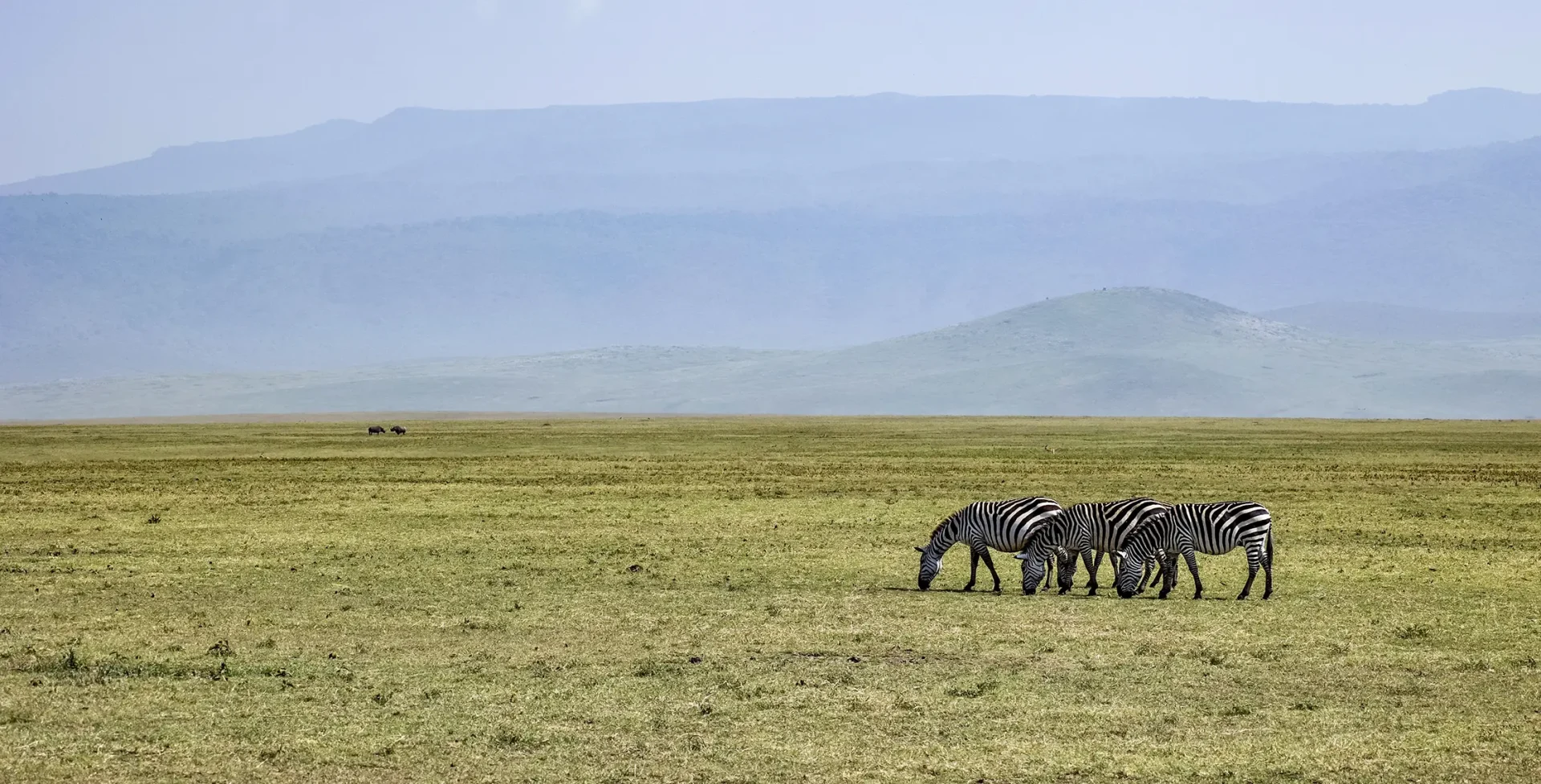
May – Golden Transitions and Emerging Wildlife
May is a time of quiet transition. The rains begin to subside, and the landscape starts to shift from deep green to golden hues. The Crater still feels fresh and alive, with cleaner air, blossoming acacias, and new animal activity. It’s a month of balance—between wet and dry, solitude and activity—offering travelers the best of both seasons.
Wildlife:
With grasses beginning to recede, animal visibility improves. Herbivores like zebras, wildebeest, and elands become easier to spot, and predators reappear in the open. Elephants are particularly active, using the soft soil to dig for roots. Buffalo, warthogs, and even the endangered black rhino can be seen grazing more frequently near the crater floor’s central plains.
Birdwatching:
Though many migratory species begin their return journey, the Crater still boasts over 500 species of birds, including grey crowned cranes, ostriches, and martial eagles. Waterbirds linger longer around Lake Magadi, offering close-up sightings.
Weather:
Rainfall tapers off, with occasional light showers and increasingly clear skies. Temperatures average around 22–24°C (72–75°F), with cooler nights. The Crater rim may still be misty in the mornings.
Photography:
This is a month of visual harmony—emerald tones fading into golden grasslands under clean, crisp skies. Wildlife becomes more photogenic against softer backgrounds, and the mix of dry and green textures creates depth in every frame.
Best For:
Couples and nature lovers looking for a quiet, visually beautiful safari without the full dryness of peak season. Also great for returning visitors who appreciate subtle ecological transitions.
☀️
June – Dry Season Begins and Wildlife Gathers
June marks the official start of the dry season in Ngorongoro. With rain now a memory, the grasses shorten and animals begin to congregate closer to water sources. The air is crisp, the views are wide, and game viewing improves steadily throughout the month.
Wildlife:
The Crater becomes more predictable for sightings. Lions bask on open plains, elephants gather near Lerai Forest, and herds of wildebeest, zebra, and gazelle move more visibly across the grasslands. Rhinos and leopards are spotted more frequently as the vegetation thins.
Birdwatching:
Although migratory birds have largely departed, resident birds such as kori bustards, helmeted guineafowls, and augur buzzards remain active. Raptors are often seen hunting in the clearer skies.
Weather:
Clear, dry conditions dominate. Daytime temperatures are mild (20–22°C / 68–72°F), while early mornings and nights on the Crater rim can be very chilly (as low as 5°C / 41°F). Bring layers.
Photography:
Golden lighting and excellent visibility create classic safari imagery. Animals are easy to isolate against the open terrain, and morning mists often hug the Crater rim for atmospheric shots.
Best For:
First-time safari-goers, families, and photographers wanting comfortable conditions and consistent game viewing.
☀️
July – Prime Time for Wildlife and Classic Safaris
July is one of the most rewarding months to visit Ngorongoro Crater. The dry season is in full effect, the air is crisp and clean, and wildlife viewing reaches one of its annual peaks. This is when the Crater feels truly timeless—its massive lion prides, ancient elephants, and grazing herds all moving across the dusty gold of the crater floor.
Wildlife:
All the iconic species are present and active. Lions follow zebra herds, hyenas patrol the roadsides, and elephants graze in the distance. Buffalo, hippos, and the rare black rhino are often sighted in the same game drive. Predator-prey tension is high, making for thrilling scenes.
Birdwatching:
Though the migratory species are gone, raptors are dominant and very visible. Eagles, vultures, and kestrels patrol the skies, especially as the dry conditions make hunting easier.
Weather:
Expect cool mornings and sunny days. Temperatures peak at around 21–23°C (70–73°F). Clear skies make for excellent visibility and open landscapes.
Photography:
July offers some of the best light and cleanest conditions for photography. With animals clustered near water and dramatic, dust-filtered backdrops, every game drive delivers rich visuals.
Best For:
Wildlife enthusiasts, families, and safari photographers looking for action and reliability.
☀️
August – Safari at its Most Spectacular
August continues the dry season momentum with even more concentrated wildlife, cooler weather, and prime safari conditions. It’s the height of the safari season—and for good reason.
Wildlife:
With water sources limited, most animals are drawn to permanent waterholes and swamps. Elephants gather in large numbers, buffalo herds dominate the plains, and predators are never far behind. It’s also one of the best months to spot endangered black rhinos during daylight hours.
Birdwatching:
While not the most diverse time for birding, visibility is exceptional. Raptors, ground birds like kori bustards, and scavengers like marabou storks are easy to find and photograph.
Weather:
Cool mornings, dry days, and beautiful skies. Daily highs reach about 24–25°C (75–77°F), but dawn game drives can feel icy—temperatures can drop to 6°C (43°F).
Photography:
From golden hour to high noon, August offers near-perfect lighting and composition. Dusty trails, silhouetted animals, and dynamic wildlife interactions make it a dream month for both beginner and professional photographers.
Best For:
Families, couples, photographers, and anyone looking for the best all-around safari conditions.
☀️
September – The Last Rush Before the Rains
September signals the last chapter of the dry season. While the landscape becomes increasingly dusty and brittle, the wildlife action is at its height. There’s a feeling of urgency among animals—a final push for survival before the rains return.
Wildlife:
Large aggregations of grazers remain, especially near the water-fed Gorigor Swamp and Lake Magadi. Predators remain alert and active. Hyenas, lions, and even servals may be spotted hunting in daylight. Rhinos, once elusive, are often seen grazing or resting in open areas.
Birdwatching:
As the air dries, sightings are easier. Resident species like weavers, eagles, and secretary birds continue to be prominent. A few early migratory arrivals may be spotted late in the month.
Weather:
Hotter and dustier, with highs around 26–28°C (79–82°F). Mornings remain cool, and visibility stays excellent throughout the day.
Photography:
This is the month for contrast: dusty plains, sunlit animals, and the occasional haze create a uniquely atmospheric mood. Late afternoons offer long shadows and a slight golden glow perfect for portraits.
Best For:
Photographers, seasoned safari-goers, and visitors seeking raw, unscripted wildlife experiences.
🍂
October – Tension, Heat, and High Drama
October brings the dry season to its climax. With parched earth and drying waterholes, animals congregate in extreme numbers—and so do predators. It’s a month of high drama, hot sun, and one last spectacular show before the rains transform everything once more.
Wildlife:
This is one of the most dramatic times for predator sightings. Lions, cheetahs, and hyenas compete for dwindling prey. Elephants kick up dust as they trek in search of water, and scavengers gather in numbers. Hippos are often seen out of the water during cooler times of the day.
Birdwatching:
Resident birds dominate the skies and forests. Raptors and vultures are especially active, taking advantage of the increased predation events.
Weather:
Dry and warm, with occasional pre-rain humidity building by late afternoon. Temperatures reach up to 29°C (84°F).
Photography:
October’s light is hard and dramatic. Scenes are high in contrast, raw, and intensely cinematic. Every dust plume, predator chase, or gaze across the plains feels epic.
Best For:
Photographers and returning visitors who want to witness nature’s raw, unscripted final act before the season resets.
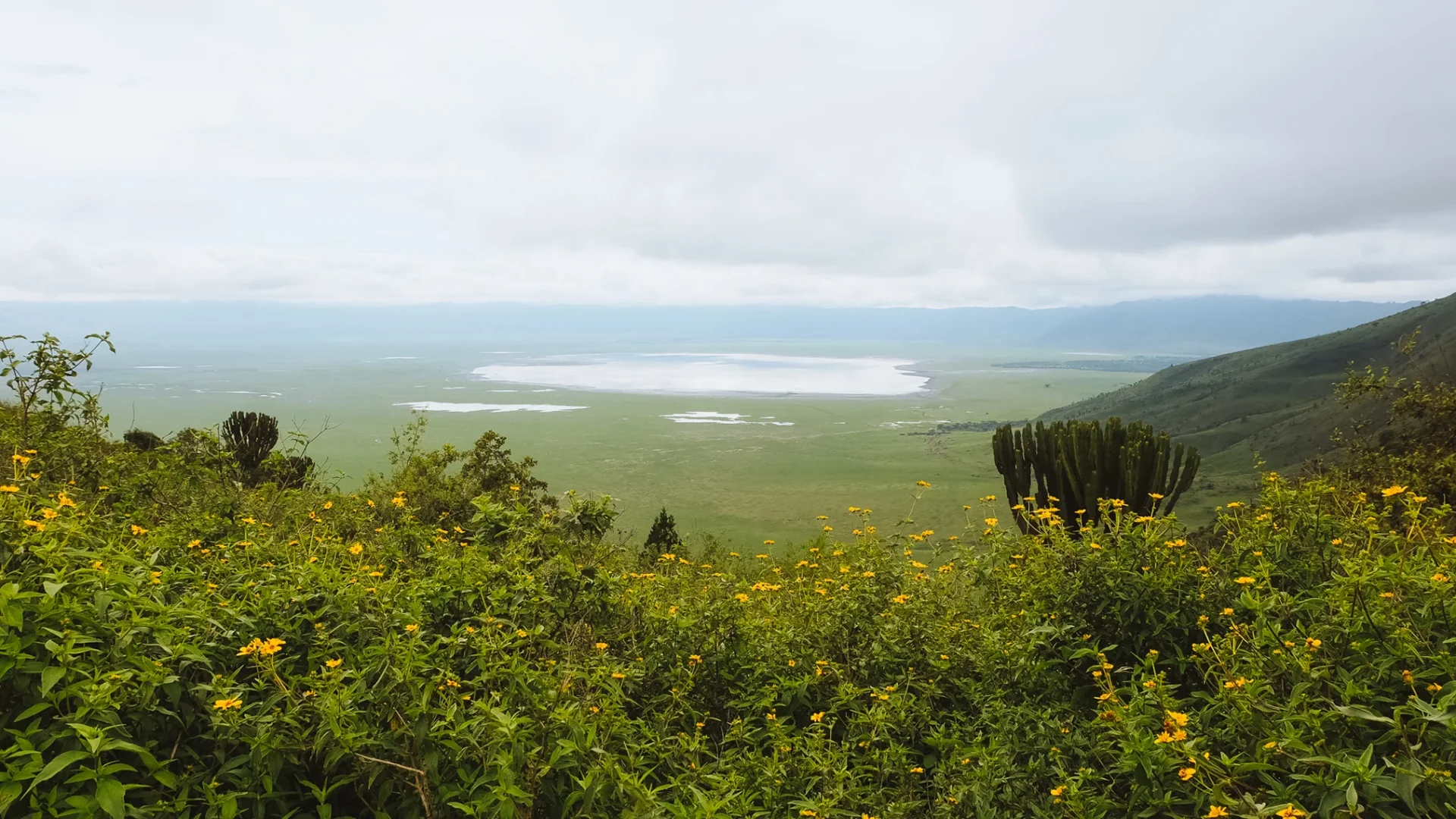
🌧️
November – Renewal and Return
November ushers in the short rains, transforming the Crater from golden dust to emerald grass almost overnight. The pace slows, the air smells of wet earth and life returning, and migratory birds arrive in brilliant flocks. It’s a time of quiet transformation—and for travelers, a rewarding off-peak secret.
Wildlife:
While some animals begin to disperse slightly, the Crater’s closed ecosystem keeps the Big Five within reach. Elephants, lions, rhinos, and large herbivores remain active, though the energy shifts from aggression to renewal.
Birdwatching:
This is the start of the migratory season. European storks, bee-eaters, and various wetland birds begin to arrive, signaling a seasonal reset for birders.
Weather:
Afternoon storms are common but often brief. Days average 24–26°C (75–79°F), with cooler mornings. Skies alternate between dramatic storm clouds and blue patches.
Photography:
The contrast of fresh greens against black storm clouds creates painterly images. Bird photography becomes vibrant again, and wet wildlife in soft light tells new stories.
Best For:
Birders, romantic travelers, and those looking to avoid crowds while still enjoying reliable wildlife.
🎄
December – Festive Season, Flourishing Life
December is when the Crater comes fully alive again—lush, green, and bursting with life. The festive season brings travelers in search of warmth and wonder, and Ngorongoro doesn’t disappoint. The landscape is dazzling, the wildlife abundant, and the mood quietly joyful.
Wildlife:
Young animals begin to appear again, signaling the start of the calving season. Predator sightings remain good, especially near forest edges and open plains. Elephants are particularly active, often seen bathing or feeding near the forest.
Birdwatching:
Birdlife is at its most colorful and varied. Migratory species are now widespread, and resident birds begin mating displays. Lakes are busy with waterfowl and waders.
Weather:
Expect warm, humid days (26–28°C / 79–82°F), with scattered showers that rarely last long. Mornings can be misty and magical on the rim.
Photography:
Rich colors, dramatic skies, and animal family scenes make December a beautiful time to shoot. Reflections in water puddles and the soft glow of overcast days enhance mood.
Best For:
Families on holiday, romantic escapes, and birders wanting the best of both resident and migratory species.
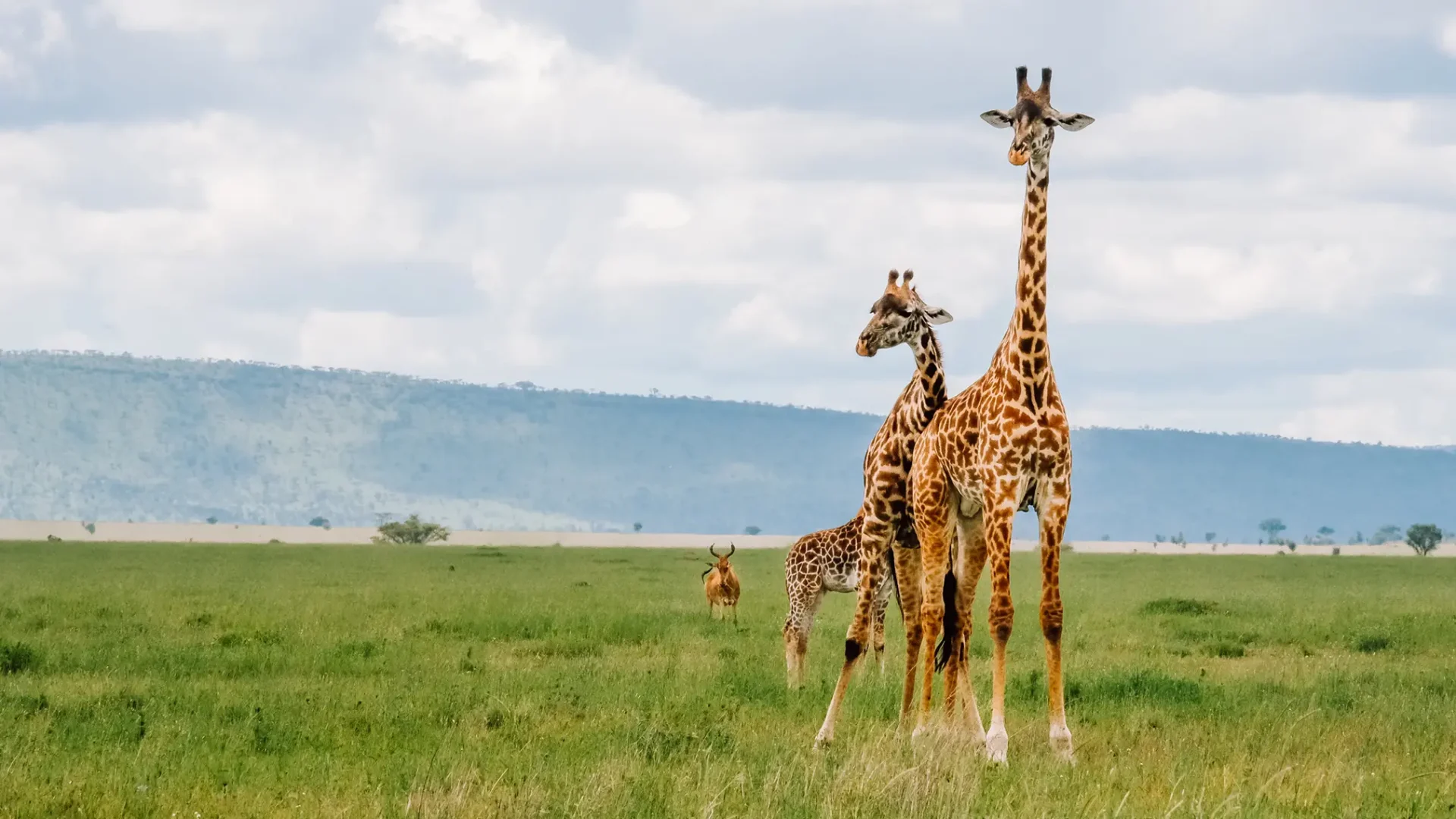
There’s No Wrong Time to Visit Ngorongoro—Only Different Stories to Witness
Ngorongoro Crater isn’t just a destination—it’s a rhythm, a cycle, a living masterpiece. Unlike other parks that empty out with the seasons, Ngorongoro always holds its cast: lions in the long grass, rhinos in the mist, elephants in the swamp, and flamingos across the alkaline lake. What changes is how they move, how they live, and how they make you feel when you meet them.
Come in January, and you’ll see new life wobbling into the world. Visit in July, and you’ll witness the raw power of predator and prey. Return in November, and you’ll feel the land exhale as rains fall and everything comes back to life. Each month offers not just a different safari—but a different way to connect with the Crater.
For first-timers, any time is the right time. For photographers, June through October will fill your lens with light and drama. For birders, the green months bring the skies to life. For romantics and families, the shoulder seasons offer quiet roads, private sightings, and landscapes that feel painted just for you.
No two days are ever the same in Ngorongoro—and that’s the magic. It’s not just what you see. It’s when you see it.

